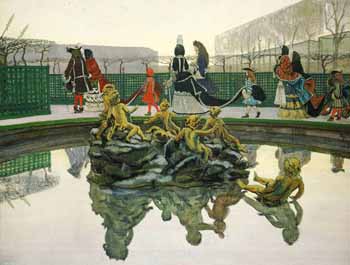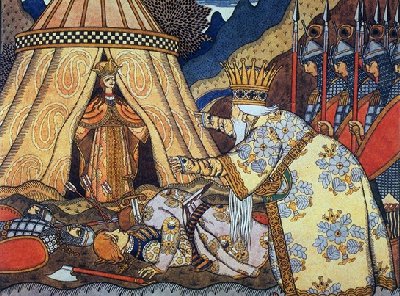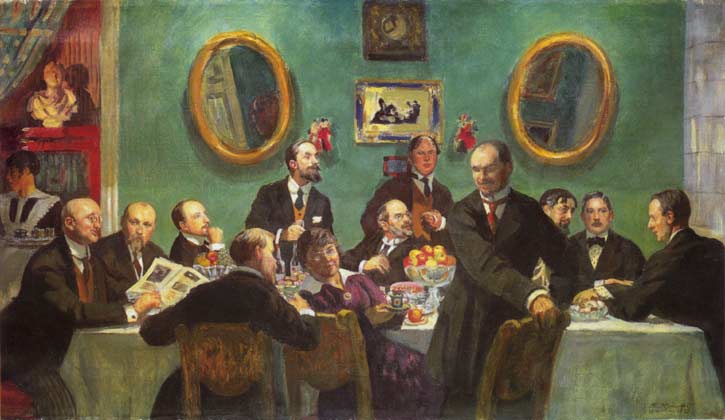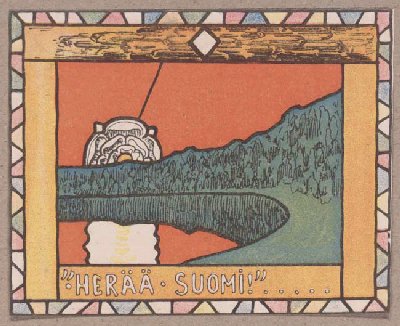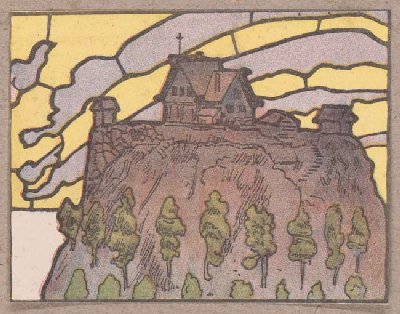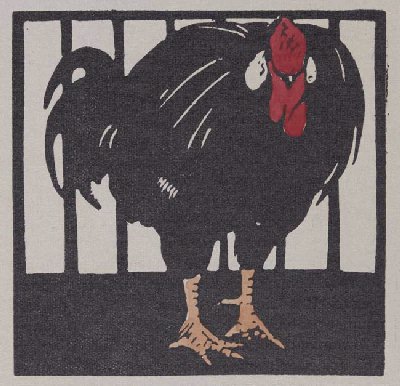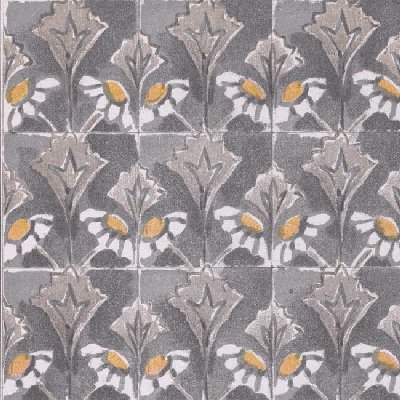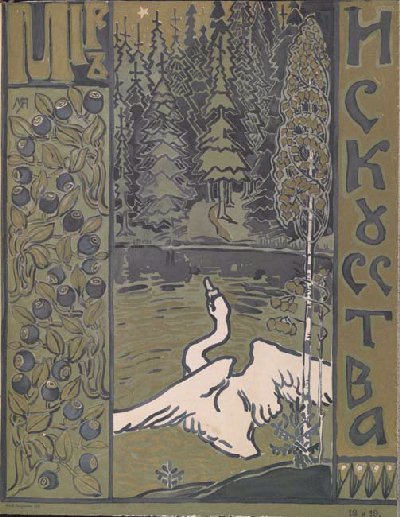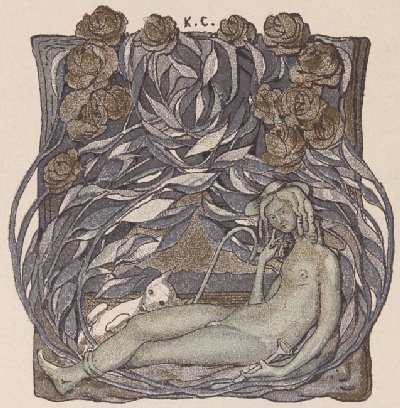| World of Art
The Art History Archive - Art Movements
"In a word I see the future through a magnifying glass." — Serge Diaghilev, 1897.
World of Art (Mir iskusstva in Russian) was an artistic movement inspired (and embodied) by an art magazine which served as its manifesto de facto, which was a major influence on the Russians who helped revolutionize European art during the first decade of the 20th century. Few Westerner/Europeans actually saw issues of the magazine itself and so the movement itself is somewhat of a mystery is Westerners and Europeans. The artistic group was founded in 1898 by a group of students that included Alexandre Benois, Konstantin Somov, Dmitry Filosofov, Léon Bakst, Eugene Lansere. The first public showing of the group was at the Exhibition of Russian and Finnish Artists in the Stieglitz Museum of Applied Arts in Saint-Petersburg. In 1899 they founded the magazine in St. Petersburg by Alexandre Benois, Léon Bakst, and Sergei Diaghilev (the Chief Editor). They aimed at assailing low artistic standards of the obsolescent Peredvizhniki school and promoting artistic individualism and other principles of Art Nouveau. The theoretical declarations of the art movements were stated in the Dyagilev's articles "Difficult Questions", "Our Imaginary Degradation", "Permanent Struggle", "In search of the Beauty", "The fundamentals of the artistic appreciation" published in the N1/2 and N3/4 of the new journal.
The most active members of the World of Art were Mstislav Dobuzhinsky, Eugene Lansere, and Konstantin Somov. Exhibitions organized by the World of Art attracted many illustrious painters from Russia and abroad, notably Mikhail Vrubel, Mikhail Nesterov, and Isaac Levitan. The group went through an initial exhibition phase (modelled off the first impressionist exhibitions) from 1898 to 1904 during which time they organized six exhibitions: 1899 (International), 1900, 1901 (At the Imperial Academy of Arts, Saint Petersburg), 1902 (Moscow and Saint Petersburg), 1903, 1906 (Saint Petersburg). The sixth exhibition was seen as a Dyagilev's attempt to prevent the separation from the Moscow mebers of the group who organized a separate "Exhibition of 36 artists" (1901) and later "The Union of Russian Artists" group (from 1903). In 1909, many of the members of the World of Art movement also contributed to the Ballets Russes Company operating in Paris.
In 1904-1910, Mir Iskusstva as a separate artistic group did not exist. Its place was inherited by the Union of Russian Artists which continued officially until 1910 and unofficially until 1924. The Union included painters (Valentin Serov, Konstantin Korovin, Boris Kustodiev, Zinaida Serebriakova), illustrators (Ivan Bilibin, Konstantin Somov), restorators (Igor Grabar), and scenic designers (Nicholas Roerich, Serge Sudeikin). In 1910 Benois published a critical article in the magazine "Rech'" about the Union of Russian Artists. Mir Iskusstva was recreated. The new chairmen became Nicholas Roerich. The group took new members including Nathan Altman, Vladimir Tatlin, Martiros Saryan. Some said that the inclusion of the Russian avant-garde painters demonstrated that the group became an exhibition organization rather than an art movement. In 1917 the chairmen of the group became Ivan Bilibin. The same year most members of Jack of Diamonds enter the group.
The group organazied numerous exhibitions: 1911, 1912, 1913, 1915, 1916, 1917, 1918, 1921, 1922 Saint-Petersburg, Moscow). The last exhibition of Mir Iskusstva was organized in Paris in 1927. Some members of the group entered the Zhar-Tsvet (Moscow, organized in 1924) and Four Arts (Moscow-Leningrad organized in 1925) artistic movements. Like the English pre-Raphaelites before them, Benois and his friends were disgusted with anti-aesthetic nature of modern industrial society and sought to consolidate all Neo-Romantic Russian artists under the auspices of fighting Positivism in art. Like the Romantics before them, the World of Art group promoted understanding and conservation of the art of previous epochs, particularly traditional folk art and the 18th-century rococo. Antoine Watteau was probably the single artist whom they admired the most.
Such Revivalist projects were treated by the group humorously, in a spirit of self-parody. They were fascinated with masks and marionettes, with carnaval and puppet theater, with dreams and fairy-tales. Everything grotesque and playful appealed to them more than the serious and emotional. Their favorite city was Venice, so much so that Diaghilev and Stravinsky selected it as a place of their burial. As for media, the group preferred light, airy effects of watercolor and gouache to full-scale oil paintings. Seeking to bring art into every house, they often designed interiors and books. Bakst and Benois revolutionized theatrical design with their ground-breaking decor for Cléopâtre (1909), Carnaval (1910), Petrushka (1911), and L'après-midi d'un faune (1912). Interested in Russian Art? See also Russian Constructivism.
The Journal Mir iskusstva (World of Art) Serge Diaghilev, Russian impresario extraordinaire, was an imposing person. Perhaps best remembered as the man behind the Ballets Russes, the legendary dance company that took Paris by storm in 1909, he was known to his inner circle as Seriozha, and sometimes, in later years, to dancers who worked for him, as Big Serge. Reputedly he was of only medium height but he had wide shoulders and a large head (many of his contemporaries made this observation). But more than anything, he had big ideas and grand attitudes. When he wrote to his artist friend, Alexander Benois, that he saw the future through a magnifying glass, he could have been referring to any of his endeavours in the arts. Or even to his extreme obsessions, such as his fear of dying on water and his consequent deep reluctance to travel anywhere by boat. But in fact, in this instance, he was referring specifically to his vision for the establishment of an art journal. This remarkable journal, Mir iskusstva (World of Art), which went into production in 1898 with Diaghilev as editor-in-chief, was financed by two influential Moscow-based patrons of Russian art. They were Savva Mamontov and Princess Maria Tenisheva, each of whom had established artists’ colonies in the countryside outside Moscow. Both nourished a particular desire to promote the Russian arts and crafts movement. The journal they backed was published in St Petersburg and appeared twice monthly until 1900 and then monthly until 1904. In essence, this journal set out to champion the idea of art for art’s sake; to lead its Russian readers away from Realism, the art style that was dominant in Russia at the time, and to introduce them to the freer styles that were flourishing throughout Europe. In the first two issues of Mir iskusstva, Diaghilev published his manifesto for the journal in a series of four articles with the overarching title of ‘Complicated Questions’.
The National Library has a full run of Mir iskusstva. It is the only Australian library to hold copies, which were purchased in 1974 as part of a larger consignment of Russian books from a Brisbane-based professor, Andrew Field. Although Mir iskusstva has been in the Library for over 30 years, its presence was rediscovered only recently when an old card record was entered online. The newly accessible record was noticed by a Library staff member, Nick Henderson, a recent participant in the Library’s graduate program. His particular interest in art and dance had generated a catalogue search on Diaghilev, which uncovered the record. With some degree of excitement, staff called in the journals from offsite storage. Research revealed that the collection was indeed a full run. The items were officially removed from the warehouse, underwent some preservation treatment and are now housed in the Library’s Rare Books Collection. Further research generated questions about the dating of the journal. The Library’s catalogue gave the date range as 1899–1904 and this dating was corroborated by other catalogues in various corners of the world. Several leading scholars working in the field of dance research, however, have referred to Diaghilev’s ‘Complicated Questions’ manifesto as appearing in 1898, and the Bibliothèque Nationale de France in Paris, which also holds a full run, gives a start date of 1898. Yet the contents page for the National Library’s copy of the first issue, which contains the first two parts—‘Our Supposed Decline’ and ‘The Eternal Conflict’—of Diaghilev’s manifesto is numbered ‘No. 1–2 1899’. A footer indicates that the journal was passed by the censor in November 1898. Is the 1899 date merely a numbering system put in place in anticipation of an 1899 publication date? Did the approval from the censor mean that in fact the first issues did appear in 1898? Research to confirm the exact publication date of the first issues continues.
Mir iskusstva was eclectic in scope. It published the work of a wide range of Russian, European, and British artists along with critical essays and reviews of exhibitions and theatrical performances. It drew on all kinds of art and craft as illustrative material: furniture, interiors, architecture, pottery, musical instruments, clothing, jewellery, embroidery as well as painting, drawing, graphic design and sculpture. It covered a range of styles and techniques. Even the work of the English-born Charles Conder, well known in this country as one of the impressionist artists of the Heidelberg School, appeared in one issue. Aubrey Beardsley’s work was published, as were woodblocks by Japanese masters Hokusai and Hiroshige. American Diaghilev scholar, Lynn Garafola, has remarked that Mir iskusstva was ‘a breath of fresh air in a stagnant art world’. Mir iskusstva was probably Diaghilev’s greatest achievement from the period of his life that preceded the acclaimed era of the Ballets Russes. In many respects, Mir iskusstva, including the many discussions, meetings, lectures and exhibitions that led up to its establishment and surrounded its production, prepared the way for the formation of Diaghilev’s hugely influential dance company. Among the contributors to Mir iskusstva and members of the founding committee, were Leon Bakst and Alexander Benois both of whom would play significant roles in the flowering of the Ballets Russes, from its first Paris season in 1909 until 1929 when it disbanded following Diaghilev’s death. But more significantly, Diaghilev promoted a particular attitude through the journal that would inform so many of his Ballets Russes activities. Mir iskusstva promoted artistic change. It challenged the existing order. So did the Ballets Russes. Most famously, Diaghilev’s Ballets Russes generated some truly exciting collaborative ventures across the arts in the early twentieth century. Choreographers, composers and visual artists—Nijinsky, Fokine, Stravinsky, Rimsky-Korsakov, Matisse, Picasso and so many more—came together to produce ballets of a kind previously unknown. Many of the works created for the Ballets Russes, or produced by Diaghilev for the first time in the West, are still in the international repertoire today—Giselle, The Sleeping Beauty and Les Sylphides. And more and more companies around the world are finding ways to reconstruct those Diaghilev ballets that were dropped from repertoire over the course of the mid-twentieth century, most notably the Stravinsky/Nijinsky/Roerich creation Rite of Spring; Afternoon of a Faun, whose collaborators were Nijinsky, Debussy and Bakst; and Parade, the work by Cocteau, Massine, Picasso and Satie that was inspired by Diaghilev’s exhortation to Cocteau, ‘Astonish me!’ The Diaghilev enterprise also established a new audience for ballet and its influence extended beyond a theatre audience to the popular world of fashion and interior design.
The dance legacy of Diaghilev’s company lives on in Australia. It was initially perpetuated as spectacle through three tours to this country by companies tracing their lineage back to Diaghilev’s Ballets Russes: the Monte Carlo Russian Ballet touring from 1936 to 1937, the Covent Garden Russian Ballet between 1938 and 1939 and the Original Ballet Russe, 1939 to 1940. And from dancers who came to Australia on one or other of these tours, and who stayed on to teach, choreograph and direct Australian companies—Kira Bousloff, Edouard Borovansky, Helene Kirsova, a contingent of Polish dancers, Tamara Tchinarova, Anna Volkova and others—the legacy was absorbed into the very essence of dance, the human body, to be passed on in perpetuity to future practitioners. As the Australian arts community anticipates the 70th anniversary in 2006 of the arrival in Australia of the Monte Carlo Russian Ballet, and as the worldwide arts community prepares to celebrate the centenary in 2009 of Diaghilev’s first Paris season, the existence of a full run of Mir iskusstva in the National Library gives Australians working in the arts an insight into the desire to engage with the new that marked the work of Serge Diaghilev, Big Serge.
Note: In a strange twist of fate, given his fear of water, the final journey of Big Serge was by gondola. Diaghilev, this imposing and influential man, whose artistic courage changed the face of ballet forever, died in Venice. His funeral cortège proceeded by gondola to the cemetery island of San Michele, in the lagoon around which the city of Venice is built.
|
|
| |
